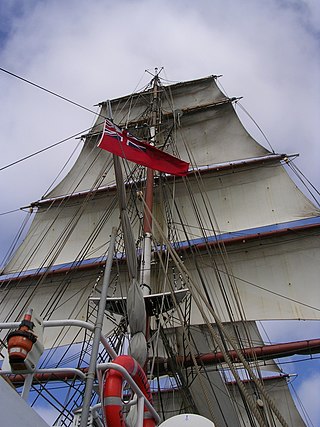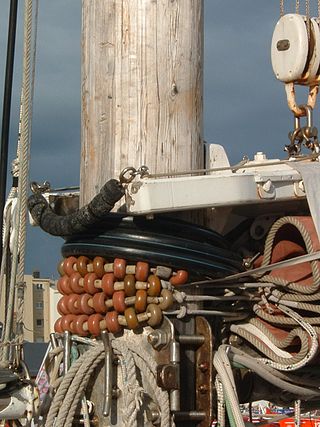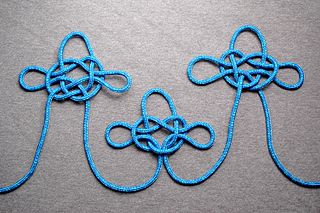
Rigging comprises the system of ropes, cables and chains, which support and control a sailing ship or sail boat's masts and sails. Standing rigging is the fixed rigging that supports masts including shrouds and stays. Running rigging is rigging which adjusts the position of the vessel's sails and spars including halyards, braces, sheets and vangs.

A sailboat or sailing boat is a boat propelled partly or entirely by sails and is smaller than a sailing ship. Distinctions in what constitutes a sailing boat and ship vary by region and maritime culture.

A sailing vessel's rig is its arrangement of masts, sails and rigging. Examples include a schooner rig, cutter rig, junk rig, etc. A rig may be broadly categorized as "fore-and-aft", "square", or a combination of both. Within the fore-and-aft category there is a variety of triangular and quadrilateral sail shapes. Spars or battens may be used to help shape a given kind of sail. Each rig may be described with a sail plan—formally, a drawing of a vessel, viewed from the side.

In sailing, a halyard or halliard is a line (rope) that is used to hoist a ladder, sail, flag or yard. The term "halyard" derives from the Middle English halier, with the last syllable altered by association with the English unit of measure "yard". Halyards, like most other parts of the running rigging, were classically made of natural fibre like manila or hemp.

In sailing, a snow, snaw or snauw is a square-rigged vessel with two masts, complemented by a snow- or trysail-mast stepped immediately abaft (behind) the main mast.

Running rigging is the rigging of a sailing vessel that is used for raising, lowering, shaping and controlling the sails on a sailing vessel—as opposed to the standing rigging, which supports the mast and bowsprit. Running rigging varies between vessels that are rigged fore and aft and those that are square-rigged.
A spar is a pole of wood, metal or lightweight materials such as carbon fibre used in the rigging of a sailing vessel to carry or support its sail. These include yards, booms, and masts, which serve both to deploy sail and resist compressive and bending forces, as well as the bowsprit and spinnaker pole.

The mast of a sailing vessel is a tall spar, or arrangement of spars, erected more or less vertically on the centre-line of a ship or boat. Its purposes include carrying sails, spars, and derricks, giving necessary height to a navigation light, look-out position, signal yard, control position, radio aerial or signal lamp. Large ships have several masts, with the size and configuration depending on the style of ship. Nearly all sailing masts are guyed.
This glossary of nautical terms is an alphabetical listing of terms and expressions connected with ships, shipping, seamanship and navigation on water. Some remain current, while many date from the 17th to 19th centuries. The word nautical derives from the Latin nauticus, from Greek nautikos, from nautēs: "sailor", from naus: "ship".

A Bermuda rig, Bermudian rig, or Marconi rig is a configuration of mast and rigging for a type of sailboat and is the typical configuration for most modern sailboats. This configuration was developed in Bermuda in the 17th century; the term Marconi, a reference to the inventor of the radio, Guglielmo Marconi, became associated with this configuration in the early 20th century, because the wires that stabilize the mast of a Bermuda rig reminded observers of the wires on early radio masts.

Square rig is a generic type of sail and rigging arrangement in which the primary driving sails are carried on horizontal spars which are perpendicular, or square, to the keel of the vessel and to the masts. These spars are called yards and their tips, outside the lifts, are called the yardarms. A ship mainly rigged so is called a square-rigger.

Belem is a three-masted barque from France.

The spritsail is a four-sided, fore-and-aft sail that is supported at its highest points by the mast and a diagonally running spar known as the sprit. The foot of the sail can be stretched by a boom or held loose-footed just by its sheets. A spritsail has four corners: the throat, peak, clew, and tack. The Spritsail can also be used to describe a rig that uses a spritsail.

Parrel beads are an element of sailing rigging. They act as roller bearings on a parrel, which is a rope or wire strop that typically fastens one spar to another along which it must have some freedom of movement. An example of this is at the jaws of a gaff on a gaff rigged or gunter rigged craft. This allows the gaff to slide up and down the mast as sail is hoisted or lowered, and allows some rotation around the mast as the sail is sheeted in and out to allow for different wind directions. Another example is on the tack of a spinnaker rigged over a furled jib.

The junk rig, also known as the Chinese lugsail, Chinese balanced lug sail, or sampan rig, is a type of sail rig in which rigid members, called battens, span the full width of the sail and extend the sail forward of the mast. While relatively uncommon in use among modern production sailboats, the rig's advantages of easier use and lower maintenance for blue-water cruisers have been explored by individuals such as trans-Atlantic racer Herbert "Blondie" Hasler and author Annie Hill.
A mast-aft rig is a sailboat sail-plan that uses a single mast set in the aft half of the hull. The mast supports fore-sails that may consist of a single jib, multiple staysails, or a crab claw sail. The mainsail is either small or completely absent. Mast-aft rigs are uncommon, but are found on a few custom, and production sailboats.

The jury mast knot is traditionally presented as to be used for jury rigging a temporary mast on a sailboat or ship after the original one has been lost; some authors claim a use for derrick poles --but there is no good evidence for actual use. The knot is placed at the top of a new mast with the mast projecting through the center of the knot. The loops of the knot are then used as anchor points for makeshift stays and shrouds. Usually small blocks of wood are affixed to, or a groove cut in, the new mast to prevent the knot from sliding downwards.

Dismasting, also spelled demasting, occurs to a sailing ship when one or more of the masts responsible for hoisting the sails that propel the vessel breaks. Dismasting usually occurs as the result of high winds during a storm acting upon masts, sails, rigging, and spars. Over compression of the mast owing to tightening the rigger too much and g-forces as a consequence of wave action and the boat swinging back and forth can also result in a dismasting. Dismasting does not necessarily impair the vessel's ability to stay afloat, but rather its ability to move under sail power. Frequently, the hull of the vessel remains intact, upright and seaworthy.
This glossary of nautical terms is an alphabetical listing of terms and expressions connected with ships, shipping, seamanship and navigation on water. Some remain current, while many date from the 17th to 19th centuries. The word nautical derives from the Latin nauticus, from Greek nautikos, from nautēs: "sailor", from naus: "ship".
















